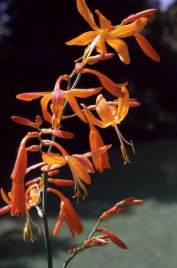Crocosmia aurea
Crocosmia aurea (Pappe ex Hook.) Planch.
Family: Iridaceae
Common names: falling stars, valentine flower, montbretia (Eng.); valentynsblom (Afr.); umlunge, udwendweni (Zulu)
Introduction
This is a very attractive garden plant with a number of bright orange flowers in a full spike at the end of the flower stalk. The tall stalks make it desirable in a vase as a cut flower.

Description
Description
Falling stars have corms with long stolons. The plant grows up to 1.2 m and is often found in large colonies, in forests or forest margins. Leaves are soft and are 20-30 mm wide. They have a distinct midvein that forms a stem at the base.
This showy plant flowers in summer (January to June). The flowers are up to 40 mm in diameter, luminous orange to red and form a branched inflorescence. It bears a leathery orange capsule, which contains shiny, purplish, black, rounded seeds.
Conservation Status
Status
Least Concern (LC). This species is not threatened.
Distribution and habitat
Distribution description
Crocosmia aurea is found from the coast up to the altitude of 2 000 m above sea level in Limpopo, Mpumalanga, KwaZulu-Natal, Eastern Cape and Swaziland. It loves moist habitats e.g. stream banks, wooded kloofs, and forest margins.
Derivation of name and historical aspects
History
The genus name is derived from Greek words krokos meaning saffron and osme meaning smell. This came about because when dried flowers are placed in warm water, they emit a strong smell of saffron. The species name is derived from a Latin word aurea meaning golden, which refers to the flowers.
The main characteristics of the genus Crocosmia is that the flower lobes are spreading and the plants are dormant in winter. There are nine species in this genus, and seven of them occur in South Africa.
C. aurea belongs to the Iridaceae family, which is commonly known as the iris family. Members of the family have mainly corms and rhizomes. They are also characterized by sword-shaped leaves, arranged in two ranks. The flowers may be regular or irregular, with three stamens and an inferior ovary. A cosmopolitan family, consisting of approximately 82 genera and 1 700 species. Thirty-eight genera and over half the species occur in South Africa.
Ecology
Ecology
It contributes significantly in its environment, as its seeds are eaten by birds and bush pigs feed on the corms.
Uses
Use
It is used in traditional medicine to treat dysentery.

Growing Crocosmia aurea
Grow
This is a very decorative shade plant that offers a combination of both attractive foliage and showy flowers. Used in a mixed planting with broad-leaved plants and fine-textured groundcovers, Crocosmia aurea can easily become a focal point. In the vase, it stands tall with its bright orange, showy flowers. If it is not controlled, it might become invasive in the flowerbed.
C. aurea can be propagated by seeds or by dividing large clumps of corms that are formed during the growing season. Seeds may be sown in a compost-based growing medium and be kept moist in a warm place. Seedlings should also be kept in a controlled environment, that is, warm temperatures until they are fully established. They will take two years to flower.
To increase stock, falling stars should be planted in large groups and be left undisturbed for some time to multiply. They can then be lifted and divided, and planted straight into the site. The corms should be planted about 4 cm deep and 20 cm apart. The ideal time to plant these is in August or early September. They may not flower well in the following season.
References
- Eliovson, S.1980. Wild flowers of southern Africa. MacMillan. Pretoria.
- Joffe, P.1993. The gardener’s guide to South African plants. Tafelberg Publishers, Cape Town.
- Pooley, E. 1998. A field guide to wild flowers Kwazulu-Natal and the eastern region. Natal Flora Publications Trust, Durban.
Credits
Mhlonishwa D. Dlamini (assisted by T.M. Mphaphuli)
Walter Sisulu National Botanical Gardens.
August 2003
Plant Attributes:
Plant Type: Bulb
SA Distribution: Eastern Cape, KwaZulu-Natal, Limpopo, Mpumalanga
Soil type: Loam
Flowering season: Late Summer, Autumn
PH: Acid, Neutral
Flower colour: Yellow, Orange
Aspect: Full Sun, Morning Sun (Semi Shade)
Gardening skill: Easy
Special Features:
Horticultural zones










Rate this article
Article well written and informative
Rate this plant
Is this an interesting plant?
User Comments
Gail Klein, United States
October 05, 2021 at 5:38 AMalways interested in photos of plants in habitat
Login to add your Comment
Back to topNot registered yet? Click here to register.